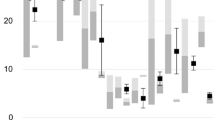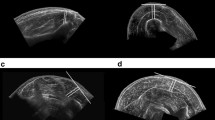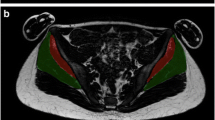Abstract
Purpose
Muscle volumes are of crucial interest when attempting to analyze individual physical performance and disease- or age-related alterations in muscle morphology. However, very little reference data are available in the literature on pelvis and lower extremity muscle volumes originating from healthy and young individuals. Furthermore, it is of interest if representative muscle volumes, covering large anatomical regions, can be obtained using magnetic resonance imaging (MRI) in a setting similar to the clinical routine. Our objective was therefore to provide encompassing, bilateral, 3-T MRI-based datasets on muscle volumes of the pelvis and the lower limb muscles.
Methods
T1-weighted 3-T MRI records were obtained bilaterally from six young and healthy participants. Three-dimensional volumes were compiled from 28 muscles and muscle groups of each participant before the muscle volumes were computed.
Results
Muscle volumes were obtained from 28 muscles and muscle groups of the pelvis and lower extremity. Volumes were larger in male than in female participants. Volumes of the dominant and non-dominant sides were similar in both genders. The obtained results were in line with volumetric data obtained from smaller anatomical areas, thus extending the available datasets.
Conclusions
This study provides an encompassing and feasible approach to obtain data on the muscle volumes of pelvic and limb muscles of healthy, young, and physically active individuals. The respective data form a basis to determine effects of therapeutic approaches, progression of diseases, or technical applications like automated segmentation algorithms applied to different populations.



Similar content being viewed by others
References
Akagi R, Tohdoh Y, Takahashi H (2013) Sex difference in strength and size ratios between reciprocal muscle groups in the lower leg. Int J Sports Med 34:449–452. doi:10.1055/s-0032-1327654
Barnouin Y, Butler-Browne G, Voit T, Reversat D, Azzabou N, Leroux G, Behin A, McPhee JS, Carlier PG, Hogrel JY (2014) Manual segmentation of individual muscles of the quadriceps femoris using MRI: a reappraisal. J Magn Reson Imaging 40:239–247. doi:10.1002/jmri.24370
Belavy DL, Miokovic T, Rittweger J, Felsenberg D (2011) Estimation of changes in volume of individual lower-limb muscles using magnetic resonance imaging (during bed-rest). Physiol Meas 32:35–50. doi:10.1088/0967-3334/32/1/003
Berg HE, Tedner B, Tesch PA (1993) Changes in lower limb muscle cross-sectional area and tissue fluid volume after transition from standing to supine. Acta Physiol Scand 148:379–385. doi:10.1111/j.1748-1716.1993.tb09573.x
Chen WM, Park J, Park SB, Shim VP, Lee T (2012) Role of gastrocnemius-soleus muscle in forefoot force transmission at heel rise—a 3D finite element analysis. J Biomech 45:1783–1789. doi:10.1016/j.jbiomech.2012.04.024
Cotofana S, Hudelmaier M, Wirth W, Himmer M, Ring-Dimitriou S, Sanger AM, Eckstein F (2010) Correlation between single-slice muscle anatomical cross-sectional area and muscle volume in thigh extensors, flexors and adductors of perimenopausal women. Eur J Appl Physiol 110:91–97. doi:10.1007/s00421-010-1477-8
Csapo R, Malis V, Sinha U, Du J, Sinha S (2014) Age-associated differences in triceps surae muscle composition and strength—an MRI-based cross-sectional comparison of contractile, adipose and connective tissue. BMC Musculoskelet Disord 15:209. doi:10.1186/1471-2474-15-209
Flack NA, Meikle GR, Reddy M, Nicholson HD, Woodley SJ (2012) Hip abductor muscle volume in women with lateral hip pain: a case-controlled study. Surg Radiolog Anat SRA 34:847–855. doi:10.1007/s00276-012-0970-7
Flack NA, Nicholson HD, Woodley SJ (2012) A review of the anatomy of the hip abductor muscles, gluteus medius, gluteus minimus, and tensor fascia lata. Clin Anat 25:697–708. doi:10.1002/ca.22004
Fukunaga T, Roy RR, Shellock FG, Hodgson JA, Day MK, Lee PL, Kwong-Fu H, Edgerton VR (1992) Physiological cross-sectional area of human leg muscles based on magnetic resonance imaging. J Orthop Res 10:928–934. doi:10.1002/jor.1100100623
Grimaldi A, Richardson C, Durbridge G, Donnelly W, Darnell R, Hides J (2009) The association between degenerative hip joint pathology and size of the gluteus maximus and tensor fascia lata muscles. Man Ther 14:611–617. doi:10.1016/j.math.2008.11.002
Handsfield GG, Meyer CH, Hart JM, Abel MF, Blemker SS (2014) Relationships of 35 lower limb muscles to height and body mass quantified using MRI. J Biomech 47:631–638. doi:10.1016/j.jbiomech.2013.12.002
Helms CA (2009) Musculoskeletal MRI. Saunders/Elsevier, Philadelphia
Kawashima S, Akima H, Kuno SY, Gunji A, Fukunaga T (2004) Human adductor muscles atrophy after short duration of unweighting. Eur J Appl Physiol 92:602–605. doi:10.1007/s00421-004-1184-4
Konishi Y, Oda T, Tsukazaki S, Kinugasa R, Hirose N, Fukubayashi T (2011) Relationship between quadriceps femoris muscle volume and muscle torque after anterior cruciate ligament rupture. Knee Surg Sports Traumatol Arthrosc 19:641–645. doi:10.1007/s00167-010-1324-9
Krainski F, Hastings JL, Heinicke K, Romain N, Pacini EL, Snell PG, Wyrick P, Palmer MD, Haller RG, Levine BD (2014) The effect of rowing ergometry and resistive exercise on skeletal muscle structure and function during bed rest. J Appl Physiol (1985) 116:1569–1581. doi:10.1152/japplphysiol.00803.2013
Maganaris CN, Baltzopoulos V, Tsaopoulos D (2006) Muscle fibre length-to-moment arm ratios in the human lower limb determined in vivo. J Biomech 39:1663–1668. doi:10.1016/j.jbiomech.2005.04.025
Maughan RJ (1984) Relationship between muscle strength and muscle cross-sectional area. Implications for training. Sports Med 1:263–269
Mersmann F, Bohm S, Schroll A, Boeth H, Duda G, Arampatzis A (2014) Muscle shape consistency and muscle volume prediction of thigh muscles. Scand J Med Sci Sports. doi:10.1111/sms.12285
Miokovic T, Armbrecht G, Gast U, Rawer R, Roth HJ, Runge M, Felsenberg D, Belavy DL (2014) Muscle atrophy, pain, and damage in bed rest reduced by resistive (vibration) exercise. Med Sci Sports Exerc 46:1506–1516. doi:10.1249/MSS.0000000000000279
Mitsuhashi N, Fujieda K, Tamura T, Kawamoto S, Takagi T, Okubo K (2009) BodyParts3D: 3D structure database for anatomical concepts. Nucleic Acids Res 37:D782–D785. doi:10.1093/nar/gkn613
Morris VC, Murray MP, Delancey JO, Ashton-Miller JA (2012) A comparison of the effect of age on levator ani and obturator internus muscle cross-sectional areas and volumes in nulliparous women. Neurourol Urodyn 31:481–486. doi:10.1002/nau.21208
O’Brien TD, Reeves ND, Baltzopoulos V, Jones DA, Maganaris CN (2009) Strong relationships exist between muscle volume, joint power and whole-body external mechanical power in adults and children. Exp Physiol 94:731–738. doi:10.1113/expphysiol.2008.045062
Ogawa M, Yasuda T, Abe T (2012) Component characteristics of thigh muscle volume in young and older healthy men. Clin Physiol Funct Imaging 32:89–93. doi:10.1111/j.1475-097X.2011.01057.x
Park JS, Chung MS, Hwang SB, Lee YS, Har DH, Park HS (2005) Visible Korean human: improved serially sectioned images of the entire body. IEEE Trans Med Imaging 24:352–360
Spitzer V, Ackerman MJ, Scherzinger AL, Whitlock D (1996) The visible human male: a technical report. J Am Med Inform Assoc 3:118–130
Tate CM, Williams GN, Barrance PJ, Buchanan TS (2006) Lower extremity muscle morphology in young athletes: an MRI-based analysis. Med Sci Sports Exerc 38:122–128
Thom JM, Morse CI, Birch KM, Narici MV (2005) Triceps surae muscle power, volume, and quality in older versus younger healthy men. J Gerontol A Biol Sci Med Sci 60:1111–1117
Walton JM, Roberts N, Whitehouse GH (1997) Measurement of the quadriceps femoris muscle using magnetic resonance and ultrasound imaging. Br J Sports Med 31:59–64
Ward SR, Eng CM, Smallwood LH, Lieber RL (2009) Are current measurements of lower extremity muscle architecture accurate? Clin Orthop Relat Res 467:1074–1082. doi:10.1007/s11999-008-0594-8
Wickiewicz TL, Roy RR, Powell PL, Edgerton VR (1983) Muscle architecture of the human lower limb. Clin Orthop Relat Res 179:275–283
Acknowledgments
The authors would like to thank Susanne Bán, Philipp Pieroh, Uwe Planitzer, Maria Schaebs, and Felix Schmidt for their aid with the segmentations. Heike Röder obtained the MRI records and Gustav F. Preller proofread the manuscript as a native speaker.
Author information
Authors and Affiliations
Corresponding author
Ethics declarations
Conflict of interest
The authors have no conflict of interest or financial disclosure related to this manuscript.
Rights and permissions
About this article
Cite this article
Lube, J., Cotofana, S., Bechmann, I. et al. Reference data on muscle volumes of healthy human pelvis and lower extremity muscles: an in vivo magnetic resonance imaging feasibility study. Surg Radiol Anat 38, 97–106 (2016). https://doi.org/10.1007/s00276-015-1526-4
Received:
Accepted:
Published:
Issue Date:
DOI: https://doi.org/10.1007/s00276-015-1526-4




